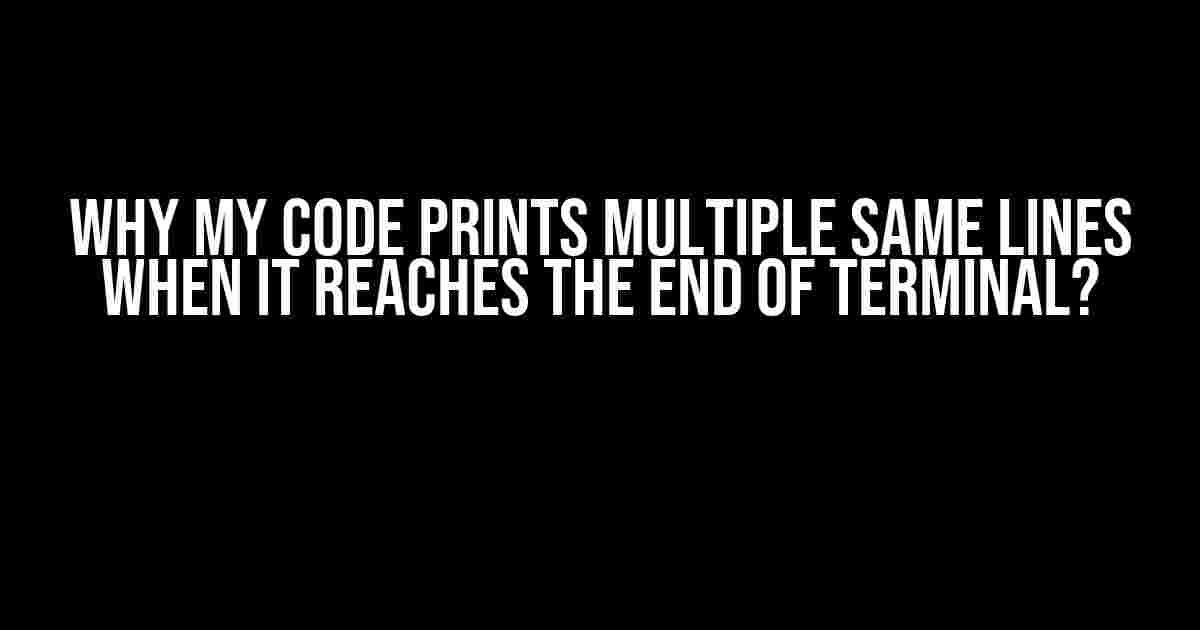Have you ever encountered a situation where your code starts printing multiple same lines when it reaches the end of the terminal? You’re not alone! This phenomenon can be frustrating, especially when you’re trying to troubleshoot your code. In this article, we’ll dive deep into the possible reasons behind this issue and provide you with practical solutions to overcome it.
The Culprits Behind the Duplicate Lines
Before we dive into the solutions, let’s first explore the common culprits behind this issue:
- Buffering Issues: When your code writes to the terminal, the output is buffered, meaning it’s stored in a temporary memory before being printed. If the buffer gets full and isn’t flushed properly, it can lead to duplicate lines being printed.
- Looping Errors: If your code has an infinite loop or a loop that doesn’t terminate correctly, it can cause the same line to be printed multiple times.
- Terminal Settings: Sometimes, terminal settings can cause issues with output buffering, leading to duplicate lines being printed.
- Code Optimizations: Some code optimizations, like caching or memoization, can lead to duplicate lines being printed if not implemented correctly.
Debugging Techniques to Identify the Issue
To identify the root cause of the issue, you can use the following debugging techniques:
- Print Statements: Add print statements at strategic points in your code to see where the duplicate lines are coming from.
- Debuggers: Use a debugger to step through your code line by line and observe the behavior.
- Logging: Implement logging mechanisms to track the execution flow of your code.
- Terminal Output Redirection: Redirect the terminal output to a file and analyze the output to identify the issue.
Solutions to the Duplicate Line Problem
Now that we’ve identified the possible causes and debugging techniques, let’s explore the solutions:
Flush the Buffer
In many programming languages, you can flush the buffer to ensure that the output is printed immediately. For example, in Python:
import sys
sys.stdout.flush()In C++, you can use:
#include <iostream>
std::cout.flush();Use a Synchronized Output Stream
In some cases, using a synchronized output stream can help prevent buffering issues. For example, in Java:
PrintStream out = new PrintStream(System.out, true);
out.println("Hello, World!");Avoid Infinite Loops
Make sure your loops have a proper termination condition to prevent infinite looping. For example:
for (int i = 0; i < 10; i++) {
System.out.println("Hello, World!");
}Configure Terminal Settings
Check your terminal settings to ensure that the output buffering is set correctly. For example, in Linux, you can use:
stty -echoThis will disable output buffering for the terminal.
Optimize Code Correctly
When using code optimizations like caching or memoization, make sure to implement them correctly to avoid duplicate lines. For example:
cache = {}
def fibonacci(n):
if n not in cache:
cache[n] = fibonacci(n-1) + fibonacci(n-2)
return cache[n]Real-World Scenarios and Examples
Let’s take a look at some real-world scenarios where duplicate lines can occur:
| Scenario | Example |
|---|---|
| Printing a list of items | for item in list: print(item) |
| Logging messages in a loop | for i in range(10): logger.info("Message %d" % i) |
| Reading from a file line by line | with open("file.txt", "r") as f: for line in f: print(line) |
Conclusion
Duplicate lines in terminal output can be frustrating, but with the right debugging techniques and solutions, you can identify and fix the issue. Remember to flush the buffer, use synchronized output streams, avoid infinite loops, configure terminal settings, and optimize code correctly. By following these tips, you’ll be able to write code that produces clean and concise output, even when it reaches the end of the terminal.
So, the next time you encounter the issue of duplicate lines, don’t panic! Simply follow the steps outlined in this article, and you’ll be well on your way to resolving the problem and producing high-quality code.
Frequently Asked Question
Get to the bottom of the mystery of duplicate lines in your terminal output!
Why does my code print multiple same lines when it reaches the end of the terminal?
This phenomenon occurs when your code uses a loop that doesn’t terminate or a recursive function without a base case, causing the program to print the same line repeatedly until it reaches the end of the terminal. Check your loops and recursive functions to ensure they have proper termination conditions!
Is it because of the buffering issue with stdout?
You’re on the right track! Buffering issues with stdout can indeed cause this behavior. When the buffer is full, the output is flushed, and if your code is still printing the same line, it will appear multiple times. Try setting the buffering mode to line-buffered or unbuffered to see if that solves the issue!
Could it be due to the way I’m handling errors?
That’s a great point! If your code is catching and handling errors in a way that causes the same line to be printed repeatedly, that could be the culprit. Make sure you’re not accidentally creating an infinite loop when handling errors, and consider logging errors instead of printing them!
What if I’m using a library or framework that’s causing the issue?
That’s a good question! If you’re using a library or framework, it’s possible that it’s causing the issue. Check the documentation and issue trackers for the library or framework to see if others have reported similar problems. You might need to update the library or framework or adjust your usage to avoid the issue!
How can I debug this issue to find the root cause?
To debug this issue, try adding debug statements or print statements with timestamps to see where the code is getting stuck. You can also use a debugger to step through the code and identify the problematic section. Additionally, consider testing your code with different inputs or scenarios to isolate the issue!
